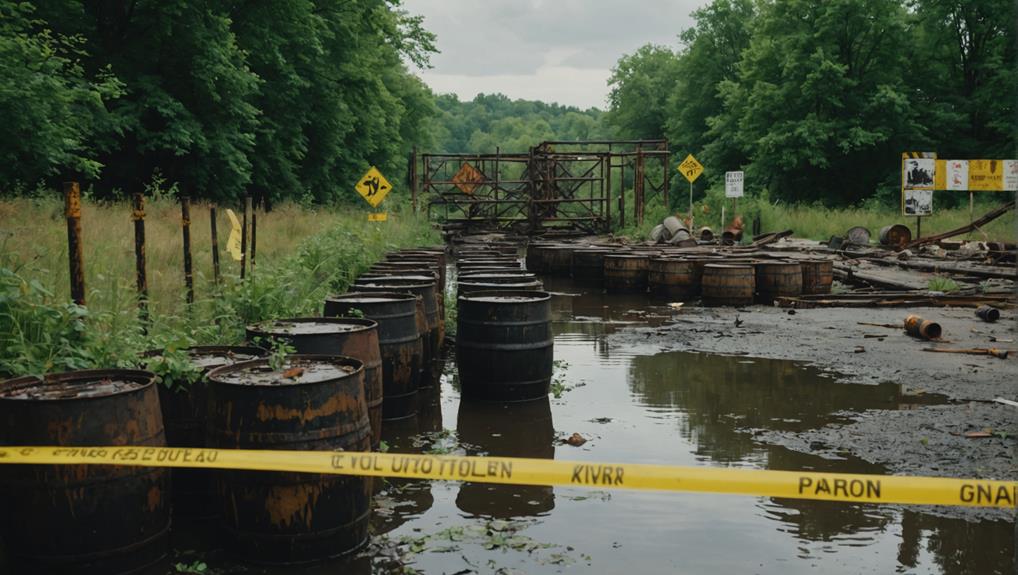Embarking on the journey of investing in commercial real estate can be both profitable and laden with potential challenges. To protect your investment, it's essential to identify key red flags that might signal underlying issues.
Poor property maintenance, inadequate due diligence, unfavorable locations, and high vacancy rates are factors that can significantly affect your investment's success. Additionally, unrealistic financial projections, legal compliance issues, and environmental hazards require thorough examination.
Identifying these warning signs early can make the difference between a wise investment and a costly error. So, what should you be on the lookout for?
Key Insights
- Poor property maintenance may indicate underlying structural issues and lead to substantial repair expenses.
- Absence of financial records suggests a lack of transparency, posing significant financial risks.
- Unrealistic financial projections can mislead investors, often resulting in financial losses.
- Legal compliance issues, such as zoning law violations and pending lawsuits, may jeopardize the investment's viability.
Poor Property Maintenance

Poor property maintenance is a critical red flag in commercial real estate investing.
Visible signs of neglect, such as cracked walls and peeling paint, often indicate underlying structural issues that can affect the overall condition of the property. Deferred maintenance, where necessary repairs are postponed, can lead to high repair costs and impact long-term value.
Properties with unresolved maintenance issues, like leaking roofs or faulty plumbing, can deter potential tenants, increasing vacancy rates and reducing rental income. The absence of regular maintenance records may suggest poor management practices.
Conducting thorough building inspections before purchase is essential to uncover hidden maintenance problems that might not be apparent during initial viewings, ensuring a sound investment decision.
Inadequate Due Diligence
Inadequate due diligence exposes investors to significant financial risks, such as missing financial records that obscure a property's true economic performance.
Failure to identify poor property conditions and unclear zoning laws can also lead to unexpected repair costs and legal challenges.
Conducting thorough due diligence is essential to mitigate these risks and ensure a sound investment.
Missing Financial Records
Transparency in financial records is essential for investors evaluating the viability of a commercial real estate investment. Missing financial records can signal a lack of transparency and pose significant risks, affecting property valuation, cash flow, and operational efficiency.
Conducting thorough due diligence is crucial to uncover any hidden financial issues that could impact the investment's profitability. Key financial documents to review include:
- Profit and loss statements
- Tax returns for the past three years
- Cash flow reports
Inadequate due diligence regarding these records can lead to unexpected expenses and hinder the property's ability to secure financing.
Comprehensive financial documentation is critical for making informed investment decisions.
Poor Property Condition
Conducting a thorough inspection of a property's physical condition is essential to identify any potential structural issues that could lead to significant repair costs and long-term liabilities.
Signs of poor property condition, such as cracked walls or leaking roofs, often indicate deeper problems requiring substantial capital expenditures (capex).
Independent inspections help ensure that issues are not concealed by sellers attempting to enhance the property's appeal.
While effective property management can mitigate some risks, unresolved maintenance problems can escalate, impacting both immediate costs and the property's market value.
Assessing a property's renovation potential is crucial to determine if it aligns with your investment strategy and long-term goals.
Unclear Zoning Laws
Understanding local zoning laws is crucial for safeguarding your property investment. Unclear zoning laws can lead to significant legal issues and restrictions on property usage, potentially impacting compliance with regulations and market value. Conducting thorough due diligence is fundamental to identify potential zoning challenges and mitigate risks.
Key considerations include:
- Unexpected zoning changes can alter the utility and value of a property.
- Non-compliance may result in costly fines and legal disputes.
- Ambiguous zoning laws can obstruct financing and tenant attraction.
Unfavorable Location

An unfavorable location can significantly impact the success of a commercial real estate investment, especially if the property suffers from limited accessibility or is situated in a declining neighborhood.
Properties that are hard to reach or far from transportation hubs often struggle to attract tenants, as businesses prioritize ease of access for customers and employees.
Areas experiencing high crime rates or a shrinking population can also deter potential tenants, leading to decreased property values and reduced demand.
Limited Accessibility
Limited accessibility in commercial real estate can significantly deter potential tenants and customers, leading to higher vacancy rates and reduced rental income.
Properties in suboptimal locations with limited accessibility often struggle to attract market demand and maintain tenant retention.
Key factors to consider include:
- Location: Proximity to major transportation routes and urban centers.
- Accessibility: Ease of access via public transport and major highways.
- Market Demand: High demand often correlates with well-connected properties.
A study by the Urban Land Institute found that properties in well-connected locations can command rental premiums of up to 20%.
Ensuring strong connectivity and ease of access is critical for long-term profitability and tenant satisfaction.
Declining Neighborhood
Accessibility is crucial in attracting tenants, but investing in commercial real estate requires careful evaluation of the neighborhood's overall trajectory to avoid areas in decline.
Declining neighborhoods often show decreasing property values and high vacancy rates, typically exceeding 10%, which signal underlying issues. Monitoring market trends and tenant mix is essential, as demographic shifts like population decline or reduced median income can significantly impact demand for commercial spaces.
Inadequate infrastructure and limited access to critical services can further deter potential tenants. While local government initiatives may promise future growth, these projects often take years to materialize, posing significant risks for investors seeking stable returns.
High Vacancy Rates
High vacancy rates, often exceeding 10%, are a significant indicator of challenges in commercial real estate investments. These rates can reveal concerns that impact the property's viability and profitability.
Critical factors to consider include:
- Tenant stability: High vacancy rates suggest difficulties in retaining long-term tenants, resulting in inconsistent cash flow.
- Local economic conditions: Poor economic health in the area can deter potential tenants, worsening vacancy issues.
- Marketing costs: Continuously filling vacant units increases marketing and tenant acquisition expenses.
Analyzing these factors is essential before making an investment decision.
Unrealistic Financial Projections

Unrealistic financial projections can significantly mislead investors, potentially resulting in substantial financial losses and misguided investment decisions. High returns that outpace market averages often signal misrepresentation. Projections must account for market liquidity and fluctuations, affecting net operating income (NOI) and property values. Detailed supporting data such as historical performance metrics and market analysis are crucial. Be cautious of aggressive growth assumptions, including inflated rental rates without evident demand, and models ignoring vacancy rates and management costs. These factors heavily influence NOI, capitalization rate (cap rate), and return on investment (ROI).
Key indicators to watch for include:
| Indicator | Red Flag |
|---|---|
| Projected ROI | Significantly higher than market average |
| NOI Assumptions | Overly optimistic without accounting for fluctuations |
| Cap Rate | Unrealistically low, indicating inflated property values |
| Vacancy Rates | Excluded or set unrealistically low |
| Management Costs | Not incorporated, leading to skewed financial projections |
Legal Compliance Issues
Legal compliance is a crucial element in commercial real estate investing that demands close attention. Neglecting this aspect can result in significant financial and operational difficulties.
Key areas to focus on include:
- Zoning laws: Verify that the property adheres to local zoning regulations to avoid fines and operational restrictions.
- Environmental assessments: Conduct comprehensive environmental assessments to identify potential liabilities.
- Due diligence: Investigate any pending lawsuits or legal disputes related to the property to mitigate unforeseen risks.
Engaging legal counsel throughout the transaction process is essential. This ensures that your investment remains secure and compliant with all regulatory requirements.
Environmental Hazards

Addressing environmental hazards is vital in commercial real estate investing to safeguard property value and avoid substantial remediation costs.
Soil contamination and hazardous waste can significantly impact property values. Conducting an Environmental Site Assessment (ESA) before purchasing is essential to identify potential risks and compliance issues.
Properties near industrial sites may be exposed to air and water pollution, leading to legal liabilities and reduced tenant interest. Federal regulations like CERCLA can hold property owners responsible for cleanup costs, regardless of fault.
These hazards can also affect financing options, as lenders might require supplementary assessments or refuse to finance high-risk properties, complicating investment strategies.
Summing it Up
To make informed decisions in commercial real estate investments, it is essential to pay close attention to potential red flags.
Key indicators to evaluate include poor property maintenance, missing financial records, unrealistic financial projections, legal compliance issues, unfavorable locations, high vacancy rates, and environmental hazards.
Identifying these warning signs can help investors mitigate risks, protect their investments, and ensure long-term profitability in the commercial real estate market.




